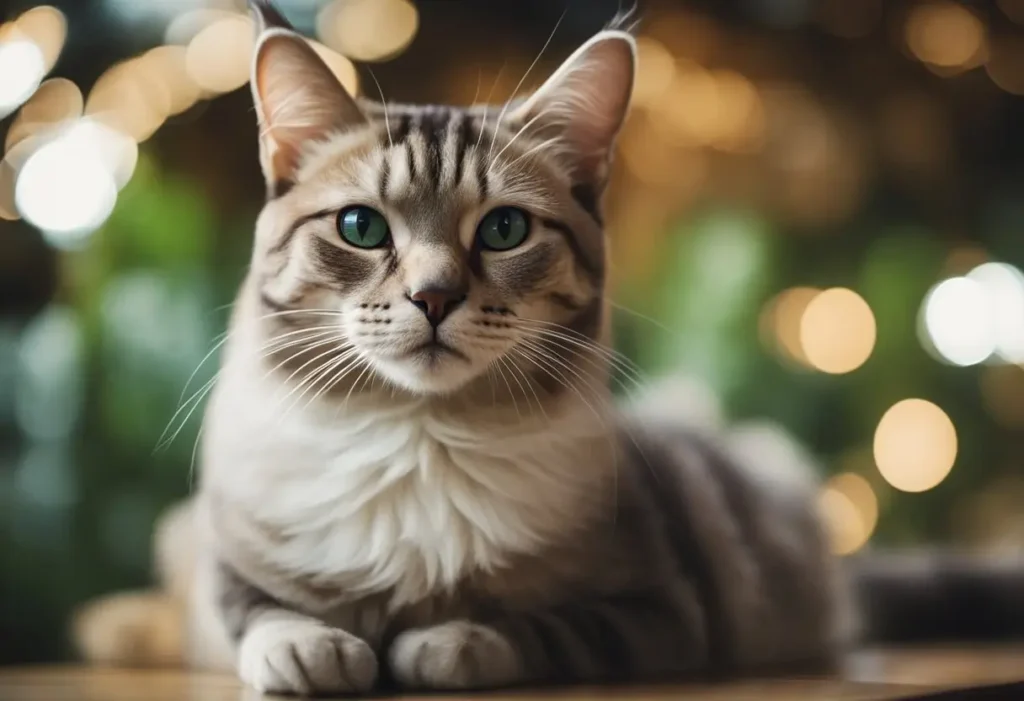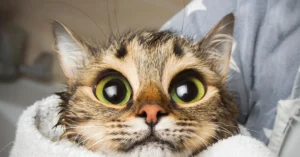The Thai breed of cat is an elegant and remarkable feline, originating from the magical land of Thailand. These wonderful cats are a natural breed, meaning they developed without human intervention. Thai cats have a rich history that has captivated cat enthusiasts around the world.
As one of the rare cat breeds, the Thai cat has garnered a loyal following. They first made their way to the United States as a pedigreed breed, where their distinct appearance and charming personality quickly won the hearts of many. This stunning cat breed has much to offer, making them the perfect addition to any cat-loving household.
With their unique combination of beauty and charisma, the Thai breed of cats stands out among other breeds. As we delve deeper into the world of these fascinating felines, you’ll learn what makes them so special and why cat fanciers across the globe appreciate their captivating presence.
History and Origin
We love the Thai breed of cat for its striking appearance and fascinating history. The Thai breed of cat, also known as the Wichienmaat, has its origins in Thailand, formerly known as Siam. These cats were considered sacred and often kept in temples, as they were highly revered in Thai culture. The breed has an ancient history that can be traced back to the Ayutthaya Kingdom (1351-1767), which is now modern-day Thailand.
During the 19th century, British citizens discovered the Wichienmaat and were captivated by their blue eyes, dark points, and elegant, white bodies. These unique features prompted the British to import the cats into the Western world, where they became known as Siamese cats, a term used to describe their Thai heritage.
The history of Siamese cats is further depicted in the Tamra Maew, or “The Cat-Book Poems,” which dates back to the Ayutthaya period. This ancient book describes various cat breeds, including the Korat and Nara, with the Thai breed of cat being one of the most distinguishing.
The Siamese breed’s popularity grew in the West with the presentation of a pair of Siamese cats named Siam and Darra to Captain John Arbuthnot, who acted as Vice-Consul in Bangkok. These cats gained significant attention as they were showcased in cat shows, eventually leading to further importation from Thailand.
Over time, the Siamese breed has gone through various changes and evolution due to breeding practices. The old-style Siamese cats showcased a more robust body and had different facial features compared to the modern Siamese cats known today. The Thai breed, also referred to as old-style Siamese, maintains the original appearance of the Wichienmaat and has become an increasingly popular breed.
The Thai breed of cat’s storied history and captivating charm continue to capture the hearts of cat lovers around the world. From their ancient origins in Siam to their current status as treasured companions, these stunning cats have truly earned their place among the most remarkable feline breeds.
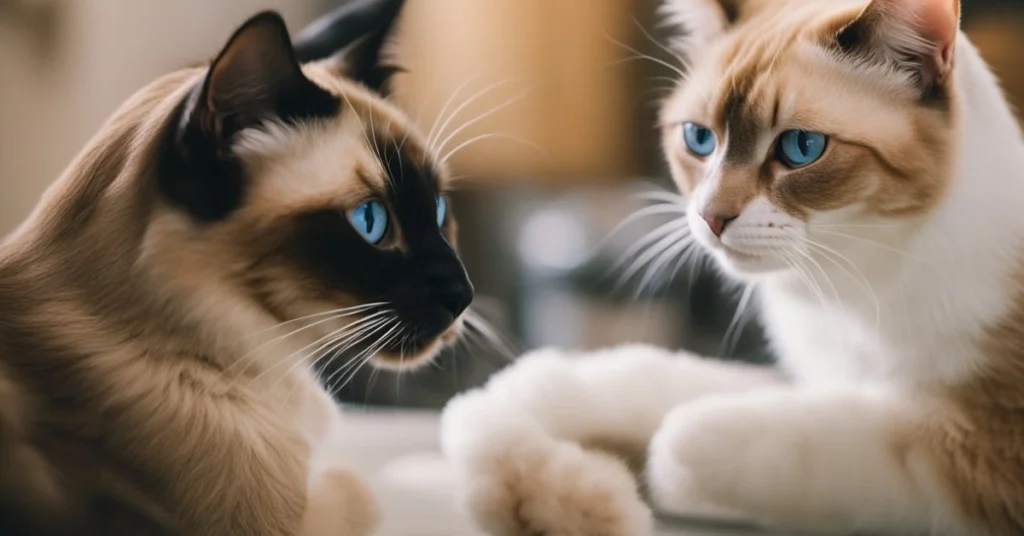
Appearance and Characteristics
As cat lovers, we’re always fascinated by the unique appearances and characteristics of different breeds. One such captivating breed is the Thai breed of cat, also known as the Traditional Siamese or Wichienmaat. Let’s dive into the distinct features of this beautiful and graceful breed that originated in Thailand.
Thai breed of cats are medium to large in size, with females typically weighing between 7 to 9 pounds and males between 9 to 12 pounds. They have a sleek, muscular body that is long and graceful but doesn’t possess the extreme slimness found in modern Siamese cats.
One of the most striking features of Thai cats is their captivating blue eyes. These gorgeous, almond-shaped eyes are a lovely shade of blue that can mesmerize anyone. The eyes are set at a slant, giving the breed an intelligent and alert expression.
Another distinctive feature of the Thai breed is their short coat, which is smooth and velvety to the touch. They have minimal shedding, making grooming a breeze. What’s more, they lack an undercoat, which further reduces the amount of hair they lose.
The coat color of Thai cats varies, but the most common color combination is an off-white to fawn base with darker color points, such as blue, chocolate, lilac, or seal. These darker, more vibrant points are usually found on their ears, tails, paws, and sometimes even their faces, giving them a remarkable contrast.
One final feature to note is the shape of the Thai breed of cat’s head. They have a modified wedge shape with a flat forehead that gives them a classy and elegant appearance. This refined facial structure, coupled with their blue eyes and distinct coat colors, makes the Thai breed of cat a true beauty in the world of felines.
All in all, the Thai breed of cat is an elegant and charming breed with an eye-catching appearance and endearing personality. So, if you’re looking for a friendly, intelligent companion with a striking look, the Thai breed of cat might just be the perfect fit for you and your family.
Breed Standards and Classification
We love the Thai breed of cat, and for good reason! They’re charming, intelligent, and deeply bonded with their people. In this section, we’ll discuss the breed standards and classification of these beautiful felines, as well as their connections to other Siamese varieties.
The International Cat Association (TICA) and other organizations like Fédération Internationale Féline (FIFe) and The Governing Council of the Cat Fancy (GCCF) develop breed standards, which are guidelines for breeders and judges in cat shows. These standards determine the ideal appearance and temperament for each breed, often with the goal of preserving the traits that make them unique.
Thai cats are related to both Traditional Siamese and Western Siamese cats, also known as Modern Siamese. Traditional Siamese cats have a more moderate body type, while Western or Modern Siamese cats have a sleeker, slender appearance. Thai breed of cats are considered pedigreed cats, sharing a common ancestry with their Siamese cousins.
As for their classification, Thai breed of cats have achieved championship status, which means they’re recognized as a separate breed and eligible for championship titles in TICA, FIFe, and other important cat registries. Breed standards for Thai cats include their overall breed profile, a strong, well-muscled body, a proportionate head with modified wedge shape, and striking blue almond-shaped eyes.
When it comes to the coat, the Thai breed of cats can have various point colors, though the most recognized ones are seal, chocolate, blue, or lilac. The coat is short, fine, and glossy, with a close-fitting texture. It’s important to note that Thai cats are a natural breed, which means they’re not a result of selective breeding and have evolved over time.
As we explore the world of Thai breed of cats, remember that these amazing animals are more than just their looks. Thai cats are intelligent, loving, and thrive in homes that offer plenty of interaction and companionship. Share your life with a Thai cat and you’ll have a loyal friend for life.
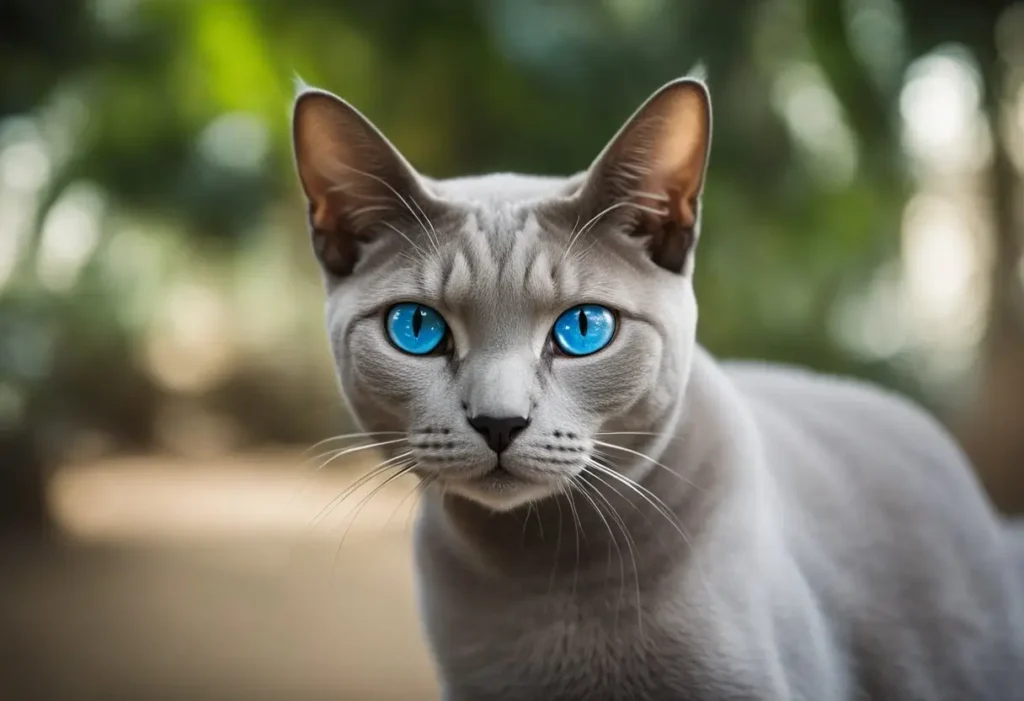
Personality and Temperament
When it comes to the Thai breed of cat, we can’t help but be charmed by their unique personality and temperament. These cats are known for being affectionate, sociable, and friendly towards their human companions, making them an ideal choice for families and cat enthusiasts alike.
One distinguishing characteristic of the Thai cat breed is their intelligence. These cats are highly curious and have a strong desire to explore their surroundings and interact with their environment. This inquisitiveness is often accompanied by playfulness, as they love engaging in games, toys, or any other form of mental stimulation.
The Thai cat’s sociable nature means that they enjoy interacting with others, be it humans or other pets. They are incredibly loyal to their owners and are known for forming strong bonds with their families. Due to their friendly temperament, they are also great with children and make exceptional companions for people of all ages.
However, it is essential to be aware of the Thai cat’s tendency to be demanding and talkative. These felines love expressing themselves through vocalization and can often be heard meowing, purring, or chattering away. While some may find this aspect of their personality endearing, others may find their chattiness to be a bit overwhelming.
In addition to their vocalizations, Thai cats are known for their desire to cuddle and be close to their loved ones. They crave physical touch and will often seek out their family members for some affectionate snuggles.
We think that the Thai breed of cat offers a unique mix of personality traits that cat owners will undoubtedly find appealing. From their intelligence and curiosity to their affectionate and friendly nature, these felines are sure to capture the hearts of those who welcome them into their homes. While they can be a bit demanding and talkative at times, their overall temperament makes them excellent companions for families and individuals alike.
Health and Lifespan
As we explore the characteristics of the Thai breed of cat, one of the crucial aspects to consider is their health and lifespan. Thai cats typically have a life expectancy of 12-16 years under proper care. However, just like any other breed, their overall health and well-being depend on various factors such as genetics, diet, exercise, and regular veterinary check-ups.
When it comes to the activity level of the Thai breed of cats, they are known for being playful and energetic, which is essential for maintaining their health. Encouraging them to engage in physical activities, whether it’s playing with toys or exploring their surroundings, can prevent obesity and keep them in good shape throughout their lives.
Speaking of obesity, it’s essential to provide the Thai breed of cats with a well-balanced diet to help them maintain a healthy weight. Overeating or consuming an inappropriate diet can lead to health issues such as diabetes, which can significantly impact their lifespan. So it’s vital to feed them the right type of food and monitor their weight regularly.
Among the health concerns that may affect the Thai breed of cat, gangliosidosis is one such genetic condition to be aware of. Gangliosidosis is a rare inherited disorder that affects the nervous system, leading to severe neurological problems. Although the condition is not very common in Thai cats, it’s essential to be aware of it and seek guidance from a veterinarian if you suspect any health issues in your feline friend.
To ensure the longevity and well-being of your Thai breed of cat, it’s important to schedule regular veterinary check-ups. A professional veterinarian will be able to detect any potential health concerns and provide appropriate treatment measures early on. Providing your Thai breed of cat with a loving and attentive environment, combined with proper diet and exercise, can help them lead a long, healthy life.
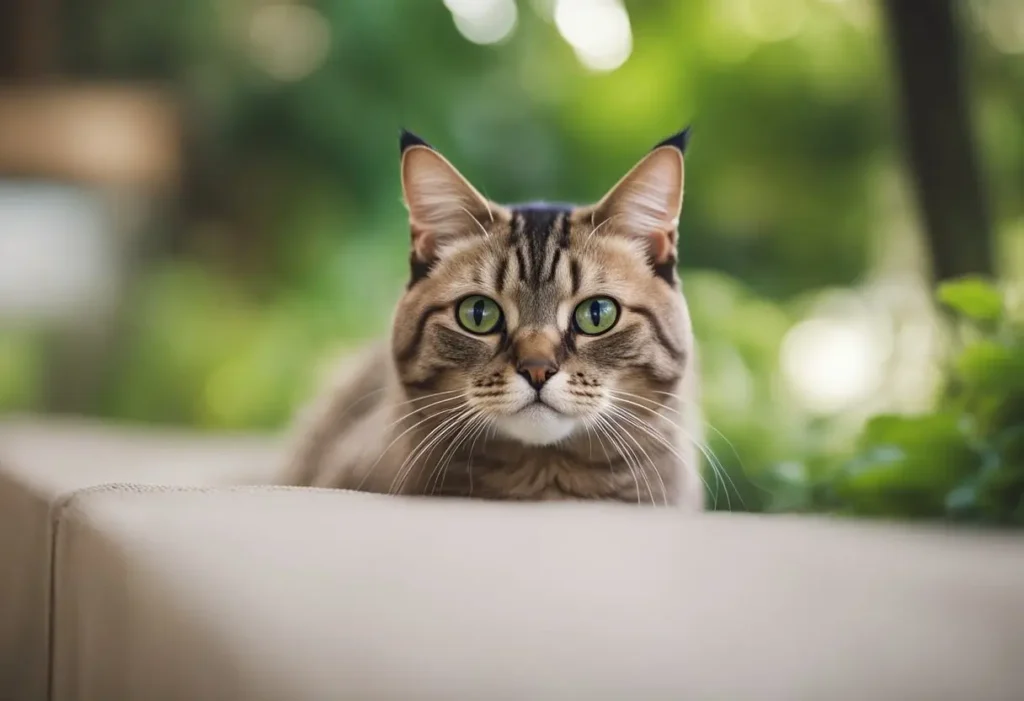
Caring for Thai Cat
As cat lovers, we know that the Thai breed of cat has unique needs and characteristics. In this section, let’s discuss the essential aspects of caring for a Thai breed of cat, covering topics such as nutrition, grooming, and providing the right environment for these sociable felines.
When it comes to nutrition, it’s important to provide Thai cats with a high-quality food. This breed thrives on high-protein, low-carbohydrate diets. Opt for a cat food that incorporates real meat or fish as the main ingredient, as excess carbohydrates can contribute to obesity, particularly later in life . Additionally, always ensure they have access to fresh water.
Grooming is relatively simple for the Thai cat. A grooming glove or a rubber brush used once or twice a week will effectively remove any dead hair without harming their coat. This low-maintenance grooming routine helps keep their coat shiny and healthy.
Bathing is usually not necessary for Thai cats, as they are generally good at keeping themselves clean. However, if they happen to get excessively dirty, a gentle, cat-friendly shampoo can be used sparingly.
One crucial aspect of Thai cat care is providing them with a dedicated space to satisfy their scratching needs. A scratching post or pad will not only help them maintain their nails but also protect your furniture from damage! Plus, this activity also helps to keep their muscles toned and healthy.
Thai cats are known to be active, athletic, and curious creatures. To keep them stimulated and satisfied, provide them with a variety of toys and opportunities for exercise. Playing with your Thai cat every day using wands and other engaging toys will keep them happy and promote a strong bond between you two.
By following these guidelines, we can ensure that our Thai cats are well-cared for and live a healthy, fulfilling life alongside their loving owners.
Thai Cat as a Family Pet
We love the Thai breed of cat, and it’s easy to see why they make an excellent family pet. These beautiful felines are known for their striking appearance, social nature, and adaptability in various households. In this section, we will discuss why Thai cats are such a great fit for families with children, how they interact with other pets, and their playful and affectionate personalities.
Thai cats are known for being exceptionally kid-friendly, making them an ideal choice for families with children. They are social, loving, and have a patient temperament that works well with the energy and curiosity of young kids. Thai cats enjoy companionship and often form strong bonds with their human family members, making them wonderful playmates and snuggle buddies for children.
In addition to being great with children, Thai cats are also pet-friendly and can adapt well to living with other household pets. They are known to get along with other cats, dogs, and even small animals like rabbits or guinea pigs. This versatility allows them to fit seamlessly into a household with existing pets, providing an opportunity for harmonious coexistence.
One of the most endearing qualities of Thai cats is their playfulness. They are highly energetic and love to engage in various play activities, from chasing toys to simply jumping and climbing around their home. Their energetic nature offers endless entertainment for their human companions, making them an excellent addition to any pet-loving household.
Lastly, Thai cats are renowned for their affection level towards their human family members. They crave attention and love to be included in daily family activities. Thai cats are known to follow their owners from room to room, showing their loyalty and dedication. This strong bond they form with their humans provides a sense of comfort and companionship that is hard to find in other breeds.
We think if you are considering adopting a cat, the Thai breed of cat is an excellent option for families with children, pet-friendly households, or simply those seeking a loving and playful companion. These beautiful cats offer a unique combination of adaptability, playfulness, and affection, making them the perfect addition to any family.
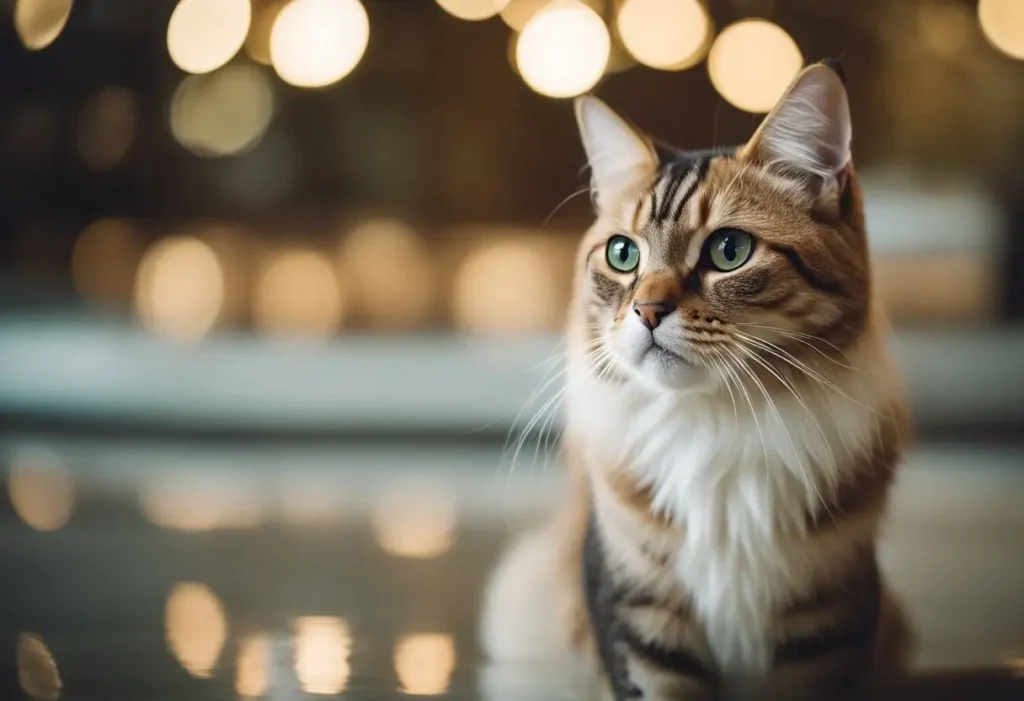
Getting a Thai breed of Cat
We absolutely love the Thai breed of cat, and we’re sure you will too! When you decide to add a Thai cat to your family, there are a few things you should know before making the commitment. These adorable felines have a rich history, unique characteristics, and specific care requirements. Let’s explore what you can expect when getting a Thai cat.
The first thing you should know is that the Thai breed of cat goes by various other names such as Wichienmaat and Old-Style Siamese cats. You may even come across their distant relatives, the Korat cat, which shares some similarities.
When looking for a Thai cat, it’s essential to find reputable breeders to ensure you’re getting a healthy and well-cared-for kitten. This means they should be experienced, knowledgeable, and ideally have a good reputation among the cat community.
Now, Thai cats are known for being smart and inquisitive, making them an exciting breed to have around your home. They are known to be sociable, talkative, and friendly with children and cat-friendly dogs, which makes them great companions for families.
There’s a lovely belief that giving a Thai cat as a gift brings good luck to the recipient. Many Thai people believe that having a Thai cat in their household will attract fortune and ward off evil spirits. Although you may not share the same belief, it’s still a delightful part of their cultural history.
If you’d like your Thai cat to be purebred, it’s crucial to find a breeder specializing in the specific breed. This will ensure you get a cat with the unique characteristics typical of the Thai breed. You may also want to inquire about show quality if you plan to enter your feline in cat shows.
Our thought if you decide to get a Thai breed of cat, make sure you are well informed about their characteristics, care requirements, and lineage. Researching reputable breeders and being diligent in your search will help guarantee a loving and joyful addition to your family. Happy cat hunting!
Important Facts and Trivia
We’re here to give you the inside scoop on the Thai breed of cat! These friendly felines have a rich history, with origins rooted in Thailand. With their dazzling blue eyes and unique appearance, it’s no wonder they’re a popular cat breed. Let’s dive into some exciting facts and trivia about this captivating breed.
In ancient Thailand, these cats were often featured in cat-book poems, illustrating their significant role in Thai culture. They were considered good luck and would often be given as gifts among friends and family to bring fortune and wellbeing.
There have been various names attributed to the Thai breed over time. Some popular names include Wichienmaat, Old-Style Siamese, and even Applehead. This variety in names comes from different groups of breeders and cat enthusiasts, each promoting the breed’s history and gene pool.
The first cat show featuring the Thai breed took place in the late 19th century, when they gained worldwide recognition and eventually became known as the Classic Siamese breed. However, over the years, selective breeding created a more modern Siamese appearance, leading to the distinction between Thai and Siamese cats.
Today, the Thai breed maintains its original features such as its modified wedge-shaped head, large ears, and flat forehead. They’re still considered medium-sized cats, with males usually weighing between 8-12 pounds and females between 6-8 pounds.
Besides their appearance, Thai cats are also known for their social and talkative nature, making them a popular choice for families looking for an active and affectionate pet. So if you’re thinking about adopting a Thai breed of cat, know that you’ll be bringing a piece of ancient Thailand’s history and a good luck charm into your home.
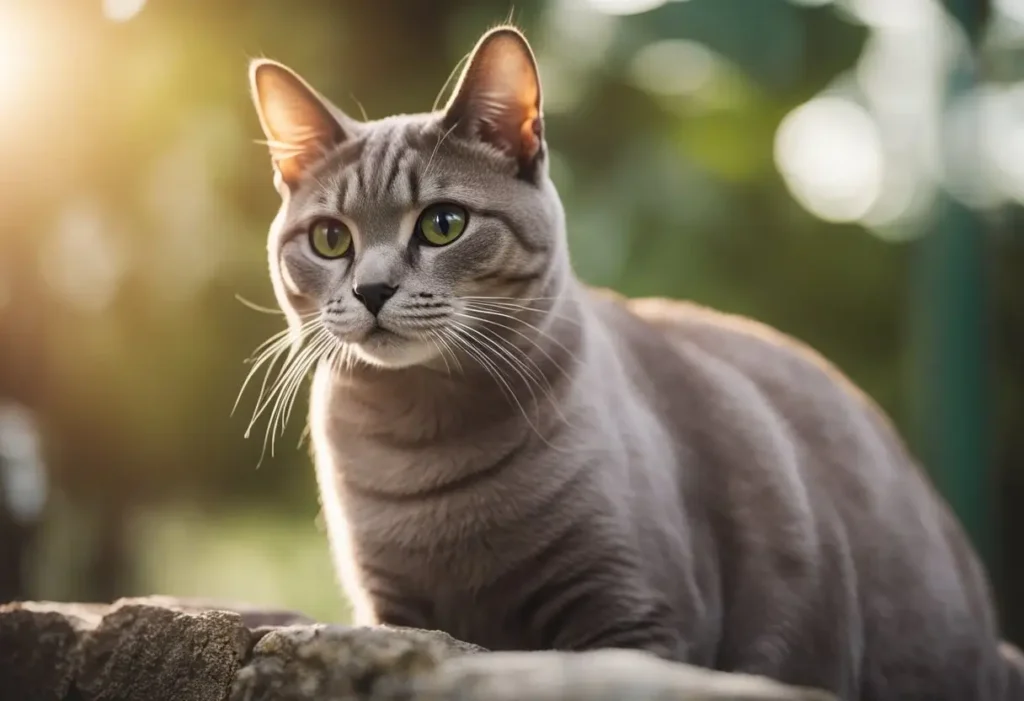
Our thoughts about the Thai breed of cat
Thai breed of cats, also known as Wichien Maat or Old-Style Siamese, are fascinating feline friends with distinct characteristics. In our experience, we have come to appreciate their uniqueness in terms of appearance and temperament. Let us share some thoughts about these beautiful cats with you.
Thai breed of cats are medium-sized, typically weighing between 8 and 15 pounds. One of their striking features is their pointed color pattern, which is similar to Siamese cats. Their rounded head, sometimes referred to as “apple head”, sets them apart from the modern Siamese cat.
In terms of temperament, we have found Thai cats to be friendly and sociable. They enjoy spending time with their human owners and are known to be loyal companions. Moreover, their intelligence is something we can’t overlook; it makes them a delightful addition to any household.
Thai cats are also fairly easy to groom. Because of their short fur, regular grooming should be sufficient to keep their coat looking clean and healthy. As for their overall health, these cats are generally robust, with only a few breed-specific health concerns.
We genuinely appreciate the Thai breed of cat for its distinctive appearance and pleasant personality. With their loyalty and intelligence, Thai cats can make exceptional companions for those who are willing to give them the love and care they deserve.
FAQ About Thai Breed Of Cat
What are some interesting facts about Thai cats?
What are some interesting facts about Thai cats?
Thai cats have a rich history, with the breed originating from Thailand (formerly known as Siam) and ultimately becoming the foundation for the modern Siamese breed1. Sometimes called Wichienmaat or Old-Style Siamese, Thai cats are a natural breed, meaning they developed without human intervention. They have been known by different names among various breeders in different times and places.
What does the Thai cat symbolize?
The Thai cat, or Wichien Maat, translates to “diamond gold” in the Thai language1. This name signifies the beauty and value of this breed. As a natural breed, these cats have a close connection to their origins in Thailand, embodying a piece of the country’s history and culture.
What are the characteristics of a Thai cat?
The Thai cat has a distinct appearance, characterized by its colorpoint pattern, striking blue eyes, and vocal nature. They are medium to large in size, with females weighing between 7 to 9 pounds and males weighing 9 to 12 pounds. Thai cats are known for their extroverted, affectionate, and inquisitive temperament. Their life expectancy ranges from 12 to 16 years.
Which breed of cat is native to Thailand?
The Thai cat is considered the native breed of cat in Thailand. This breed has deep historical roots in the country, leading to its eventual influence on the development of the modern Siamese breed.
You may also need a name for your new feline friend. Our article about the best 1000 cat names might be interesting for you.
If you are interested in fluffy cats you could read our article about fluffy cat breeds.
What are your thoughts about cats with big paws? Let us know in the comments!

